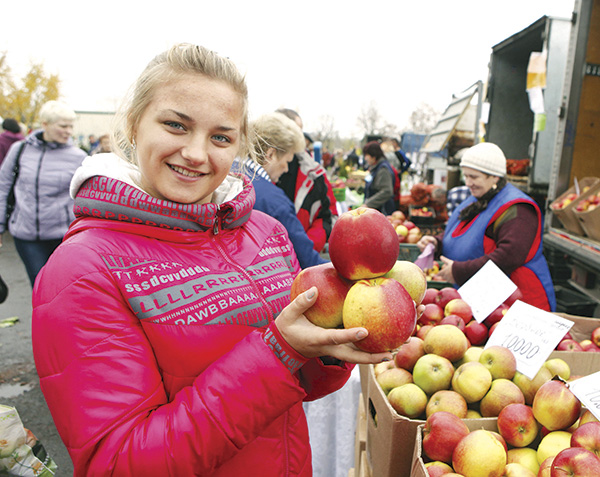
Over forty apple varieties are grown in Belarus
He notes, “People are aware of quality and are convinced of organic production, unlike some imported fruit. They’re right, since apples in the West are exposed to chemicals sometimes up to 40 times in a single season. Ours have just 10-12 such interventions and those with high immune resistance may only need to be sprayed 5-6 times. As regards taste and appearance, Belarusian apples rival those from the West and I even think that ours are better! Foreigners who’ve forgotten the natural apple smell can be surprised by the smell of ours.”
Taste purple
Are there enough varieties to satisfy demand?
Belarus has 46 apple varieties, each unique and very different. Some are sweet, while others have more acidity, and colours vary from green to deep purple, as for ‘Belarusian Raspberry-Red’. Summer apples include ‘Yelena’, ‘Kovalenkovskoe’ and ‘Melboy’, ripening in late July and early August, while ‘Belarusian Sweet’, ‘Vesyalina’, ‘Kovalenko Memory’, ‘Belarusian Raspberry-Red’, ‘Charaunitsa’, ‘Syabryna’, and ‘Darunak’ are harvested in October. ‘Belarusian Sinap’, ‘Sikora Memory’, ‘Zaslavskoe’, ‘Verbnae’, ‘Alesya’, ‘Success’ and ‘Imant’ come late in the season, being picked in November, and are able to be stored until the following summer.
Which varieties do you prefer?
‘Belarusian Sweet’ is my favourite, being full of flavour. It fully lives up to its name.
How long does it take to breed a particular variety?
In the past, selection took about 25 years, which resulted in breeders often failing to enjoy the results of their work. With this in mind, a variety mentioning a particular name tends to refer to the first scientist who began work on it. It only takes half the time now, with new varieties appearing, on average, every three years. Not long ago, we registered ‘Syabryna’, ‘Success’ and ‘Darunak’.
Orchards in bloom
Have you been pleased with recent harvests?
Over the past decade, we’ve only had one poor year. Our horticulture has proven very profitable, with rates standing at 40-60 percent. The problem is that gardening requires long-term investment. It’s not like potatoes, which can be planted in spring and harvested in autumn. It takes years for an orchard to yield fruit. We do receive state support, with a second development programme now being realised, funded centrally. Our orchards occupy 103,000 hectares of Belarusian territory, including 65,000 apple trees. Every new orchard planted uses Belarusian varieties.
Impossible to ignore!
Braslav style pie
Ingredients: 400g of apples; 500ml of milk; 125g of sugar; 15g of yeast; 2 eggs; a tablespoon of butter; 3 cups of flour; 1 teaspoon of cinnamon; and half pack of vanillin.
Method
Warm the milk and add a spoonful of sugar and the yeast.
Mix the eggs with the rest of the sugar, salt and vanillin, adding the softened butter later, and then the yeast mixture, cinnamon and sieved flour.
Knead the dough so that it’s soft without being sticky.
Leave the bowl of dough in a warm place for an hour, covered with a towel, punching half way through.
Peel the apples and remove any seeds, before cutting into thin slices and adding to the dough.
Leave in a warm place for another hour.
Oil a baking case (no larger than 20cm diameter) and line with the dough, leaving again for 40 minutes before baking at 180°С, for 35-45 minutes.
By Anatoly Sovrasov












